Reconfiguration of Distribution Networks with Simultaneous Allocation of Distributed Generation Using the Whale Optimization Algorithm
Abstract
:1. Introduction
- The WOA is implemented for the power loss reduction and the voltage curve improvement through the reconfiguration with the simultaneous allocation of DGs;
- Tests are conducted using the 33-bus and 69-bus grids in various cases by means of the WOA;
- A comparison is performed between the results acquired by WOA and the solutions presented by other techniques and the proposed method further reduces the power losses and further improves the voltage profile. As a result, it shows the superiority of WOA over other methods.
2. Problem Formulation
2.1. Objective Function
2.2. Constraints
- The obtained voltage magnitudes must not exceed the permissible limits, as presented in Equation (3);
- 2.
- The distribution grid must maintain its radiality topology and, after reconfiguration, must supply all loads;
- 3.
- The amount of power produced by the DGs must be within the permissible limits, as shown in Equation (4);
- 4.
- The nonlinear equations represent Kirchhoff’s current and voltage laws, i.e., the formulas of the power flow problem. The power flow analysis calculates the power losses for each topology with DGs.
3. DNR Problem Solution Method
3.1. Basic Loop
3.2. Radiality Constraint Checking
4. Whale Optimization Algorithm
- Enclosing the hunt;
- Bubble-net attacking manner;
- Looking for the hunt.
4.1. Enclosing the Hunt
4.2. Bubble-Net Attacking Manner
4.2.1. Shrinking Encircling Mechanism
4.2.2. Helix Updating Situation
4.3. Looking for the Hunt
5. Implementation of the WOA for DNR Considering the Allocation of DG
5.1. Initialization
5.2. Overall Procedure
6. Tests and Results
- Case 1: base case (without DNR and DGs);
- Case 2: only reconfiguration is performed;
- Case 3: the optimum placement and capacity of 3 DGs are performed after reconfiguration according to the result of Case 2;
- Case 4: the reconfiguration and the optimum placement and capacity of 3 DGs are performed simultaneously.
6.1. 33-Bus Grid
6.2. 69-Bus Grid
7. Conclusions
Author Contributions
Funding
Data Availability Statement
Conflicts of Interest
Nomenclature
| Functions | |
| Objective function of the problem | |
| Indices | |
| Indices for buses | |
| Parameters | |
| Complex power injected at bus | |
| Real power injected at bus | |
| Non−real power injected at bus | |
| Voltage magnitude at bus | |
| Current extracted at bus | |
| Total active power load | |
| Active power injection at the substation and DGs | |
| Overall real power losses of the system | |
| Voltage magnitude at bus | |
| Minimum acceptable bus voltage magnitude | |
| Maximum acceptable bus voltage magnitude | |
| Overall number of buses in the system | |
| Real power output of the DG unit | |
| Minimum size of the DG unit | |
| Maximum size of the DG unit | |
| Number of DG units | |
| Location vector of the best solution | |
| Location vector | |
| Present iteration | |
| Coefficient vectors | |
| Random vector | |
| Distance between a whale and the prey | |
| Vector with decreasing values from 2 to 0 | |
| Constant value | |
| Random number | |
| Random whales in the current iteration | |
| Initial population | |
| Number of solutions in the population | |
| Number of tie switches | |
| Status of switch | |
References
- Nguyen, T.T.; Truong, A.V.; Phung, T.A. A novel method based on adaptive cuckoo search for optimal network reconfiguration and distributed generation allocation in distribution network. Int. J. Electr. Power Energy Syst. 2016, 78, 801–815. [Google Scholar] [CrossRef]
- Bayat, A.; Bagheri, A.; Noroozian, R. Optimal siting and sizing of distributed generation accompanied by reconfiguration of distribution networks for maximum loss reduction by using a new UVDA-based heuristic method. Int. J. Electr. Power Energy Syst. 2016, 77, 360–371. [Google Scholar] [CrossRef]
- Rajaram, R.; Kumar, K.S.; Rajasekar, N. Power system reconfiguration in a radial distribution network for reducing losses and to improve voltage profile using modified plant growth simulation algorithm with distributed generation (DG). Energy Rep. 2015, 1, 116–122. [Google Scholar] [CrossRef] [Green Version]
- Tran, T.T.; Truong, K.H.; Vo, D.N. Stochastic fractal search algorithm for reconfiguration of distribution networks with distributed generations. Ain Shams Eng. J. 2020, 11, 389–407. [Google Scholar] [CrossRef]
- Biswal, S.R.; Shankar, G.; Elavarasan, R.M.; Mihet-Popa, L. Optimal allocation/sizing of DGs/capacitors in reconfigured radial distribution system using quasi-reflected slime mould algorithm. IEEE Access 2021, 9, 125658–125677. [Google Scholar] [CrossRef]
- Barnwal, A.K.; Yadav, L.K.; Verma, M.K. A multi-objective approach for voltage stability enhancement and loss reduction under PQV and P buses through reconfiguration and distributed generation allocation. IEEE Access 2022, 10, 16609–16623. [Google Scholar] [CrossRef]
- Tran, T.V.; Truong, B.-H.; Nguyen, T.P.; Nguyen, T.A.; Duong, T.L.; Vo, D.N. Reconfiguration of distribution networks with distributed generations using an improved neural network algorithm. IEEE Access 2021, 9, 165618–165647. [Google Scholar] [CrossRef]
- Shaheen, A.M.; El-Sehiemy, R.A.; Kamel, S.; Elattar, E.E.; Elsayed, A.M. Improving distribution networks’ consistency by optimal distribution system reconfiguration and distributed generations. IEEE Access 2021, 9, 67186–67200. [Google Scholar] [CrossRef]
- Rahim, M.N.A.; Mokhlis, H.; Bakar, A.H.A.; Rahman, M.T.; Badran, O.; Mansor, N.N. Protection coordination toward optimal network reconfiguration and DG sizing. IEEE Access 2019, 7, 163700–163718. [Google Scholar] [CrossRef]
- Moghaddam, M.J.H.; Kalam, A.; Shi, J.; Nowdeh, S.A.; Gandoman, F.H.; Ahmadi, A. A new model for reconfiguration and distributed generation allocation in distribution network considering power quality indices and network losses. IEEE Syst. J. 2020, 14, 3530–3538. [Google Scholar] [CrossRef]
- Macedo, L.H.; Home-Ortiz, J.M.; Vargas, R.; Mantovani, J.R.S.; Romero, R.; Catalão, J.P.S. Short-circuit constrained distribution network reconfiguration considering closed-loop operation. Sustain. Energy Grids Netw. 2022, 32, 100937. [Google Scholar] [CrossRef]
- Shukla, J.; Panigrahi, B.K.; Ray, P.K. Stochastic reconfiguration of distribution system considering stability, correlated loads and renewable energy based DGs with varying penetration. Sustain. Energy Grids Netw. 2020, 23, 100366. [Google Scholar] [CrossRef]
- Swaminathan, D.; Rajagopalan, A.; Montoya, O.D.; Arul, S.; Grisales-Noreña, L.F. Distribution network reconfiguration based on hybrid golden flower algorithm for smart cities evolution. Energies 2023, 16, 2454. [Google Scholar] [CrossRef]
- Saw, B.K.; Bohre, A.K.; Jobanputra, J.H.; Kolhe, M.L. Solar-DG and DSTATCOM concurrent planning in reconfigured distribution system using APSO and GWO-PSO based on novel objective function. Energies 2023, 16, 263. [Google Scholar] [CrossRef]
- Alonso, G.; Alonso, R.F.; Souza, A.C.Z.Z.D.; Freitas, W. Enhanced artificial immune systems and fuzzy logic for active distribution systems reconfiguration. Energies 2022, 15, 9419. [Google Scholar] [CrossRef]
- Wang, B.; Zhu, H.; Xu, H.; Bao, Y.; Di, H. Distribution network reconfiguration based on NoisyNet deep Q-learning network. IEEE Access 2021, 9, 90358–90365. [Google Scholar] [CrossRef]
- Pereira, E.C.; Barbosa, C.H.N.R.; Vasconcelos, J.A. Distribution network reconfiguration using iterative branch exchange and clustering technique. Energies 2023, 16, 2395. [Google Scholar] [CrossRef]
- Akbari, M.A.; Aghaei, J.; Barani, M.; Niknam, T.; Ghavidel, S.; Farahmand, H.; Korpas, M.; Li, L. Convex models for optimal utility-based distributed generation allocation in radial distribution systems. IEEE Syst. J. 2018, 12, 3497–3508. [Google Scholar] [CrossRef]
- Cao, X.; Wang, J.; Wang, J.; Zeng, B. A risk-averse conic model for networked microgrids planning with reconfiguration and reorganizations. IEEE Trans. Smart Grid 2020, 11, 696–709. [Google Scholar] [CrossRef]
- Purlu, M.; Turkay, B.E. Optimal allocation of renewable distributed generations using heuristic methods to minimize annual energy losses and voltage deviation index. IEEE Access 2022, 10, 21455–21474. [Google Scholar] [CrossRef]
- Tan, Y.; Wang, Z. Incorporating unbalanced operation constraints of three-phase distributed generation. IEEE Trans. Power Syst. 2019, 34, 2449–2452. [Google Scholar] [CrossRef]
- Jothibasu, S.; Dubey, A.; Santoso, S. Two-stage distribution circuit design framework for high levels of photovoltaic generation. IEEE Trans. Power Syst. 2019, 34, 5217–5226. [Google Scholar] [CrossRef]
- Meng, F.; Chowdhury, B.; Chamanamcha, M. Three-phase optimal power flow for market-based control and optimization of distributed generations. IEEE Trans. Smart Grid 2018, 9, 3691–3700. [Google Scholar] [CrossRef]
- Fathy, A. A novel artificial hummingbird algorithm for integrating renewable based biomass distributed generators in radial distribution systems. Appl. Energy 2022, 323, 119605. [Google Scholar] [CrossRef]
- Tolba, M.A.; Houssein, E.H.; Eisa, A.A.; Hashim, F.A. Optimizing the distributed generators integration in electrical distribution networks: Efficient modified forensic-based investigation. Neural Comput. Appl. 2023, 35, 8307–8342. [Google Scholar] [CrossRef]
- Wang, C.; Lei, S.; Ju, P.; Chen, C.; Peng, C.; Hou, Y. MDP-based distribution network reconfiguration with renewable distributed generation: Approximate dynamic programming approach. IEEE Trans. Smart Grid 2020, 11, 3620–3631. [Google Scholar] [CrossRef]
- Ghasemi, M.; Kazemi, A.; Gilani, M.A.; Shafie-Khah, M. A stochastic planning model for improving resilience of distribution system considering master-slave distributed generators and network reconfiguration. IEEE Access 2021, 9, 78859–78872. [Google Scholar] [CrossRef]
- Pamshetti, V.B.; Singh, S.; Singh, S.P. Combined impact of network reconfiguration and volt-var control devices on energy savings in the presence of distributed generation. IEEE Syst. J. 2020, 14, 995–1006. [Google Scholar] [CrossRef]
- Tabares, A.; Puerta, G.F.; Franco, J.F.; Romero, R.A. Planning of reserve branches to increase reconfiguration capability in distribution systems: A scenario-based convex programming approach. IEEE Access 2021, 9, 104707–104721. [Google Scholar] [CrossRef]
- Gao, Y.; Wang, W.; Shi, J.; Yu, N. Batch-constrained reinforcement learning for dynamic distribution network reconfiguration. IEEE Trans. Smart Grid 2020, 11, 5357–5369. [Google Scholar] [CrossRef]
- Sun, W.; Qiao, Y.; Liu, W. Economic scheduling of mobile energy storage in distribution networks based on equivalent reconfiguration method. Sustain. Energy Grids Netw. 2022, 32, 100879. [Google Scholar] [CrossRef]
- Bawayan, H.; Younis, M. Mitigating failure propagation in microgrids through topology reconfiguration. Sustain. Energy Grids Netw. 2020, 23, 100363. [Google Scholar] [CrossRef]
- Tiwari, S.P.; Koley, E.; Ghosh, S. Communication-less ensemble classifier-based protection scheme for DC microgrid with adaptiveness to network reconfiguration and weather intermittency. Sustain. Energy Grids Netw. 2021, 26, 100460. [Google Scholar] [CrossRef]
- Nikkhah, S.; Alahyari, A.; Allahham, A.; Alawasa, K. Optimal integration of hybrid energy systems: A security-constrained network topology reconfiguration. Energies 2023, 16, 2780. [Google Scholar] [CrossRef]
- Reddy, A.V.S.; Reddy, M.D. Application of whale optimization algorithm for distribution feeder reconfiguration. I-Manag. J. Electr. Eng. (JEE) 2018, 11, 17–24. [Google Scholar] [CrossRef]
- Mirjalili, S.; Lewis, A. The whale optimization algorithm. Adv. Eng. Softw. 2016, 95, 51–67. [Google Scholar] [CrossRef]
- Soliman, M.; Abdelaziz, A.Y.; El-Hassani, R.M. Distribution power system reconfiguration using whale optimization algorithm. Int. J. Appl. Power Eng. (IJAPE) 2020, 9, 48–57. [Google Scholar] [CrossRef]
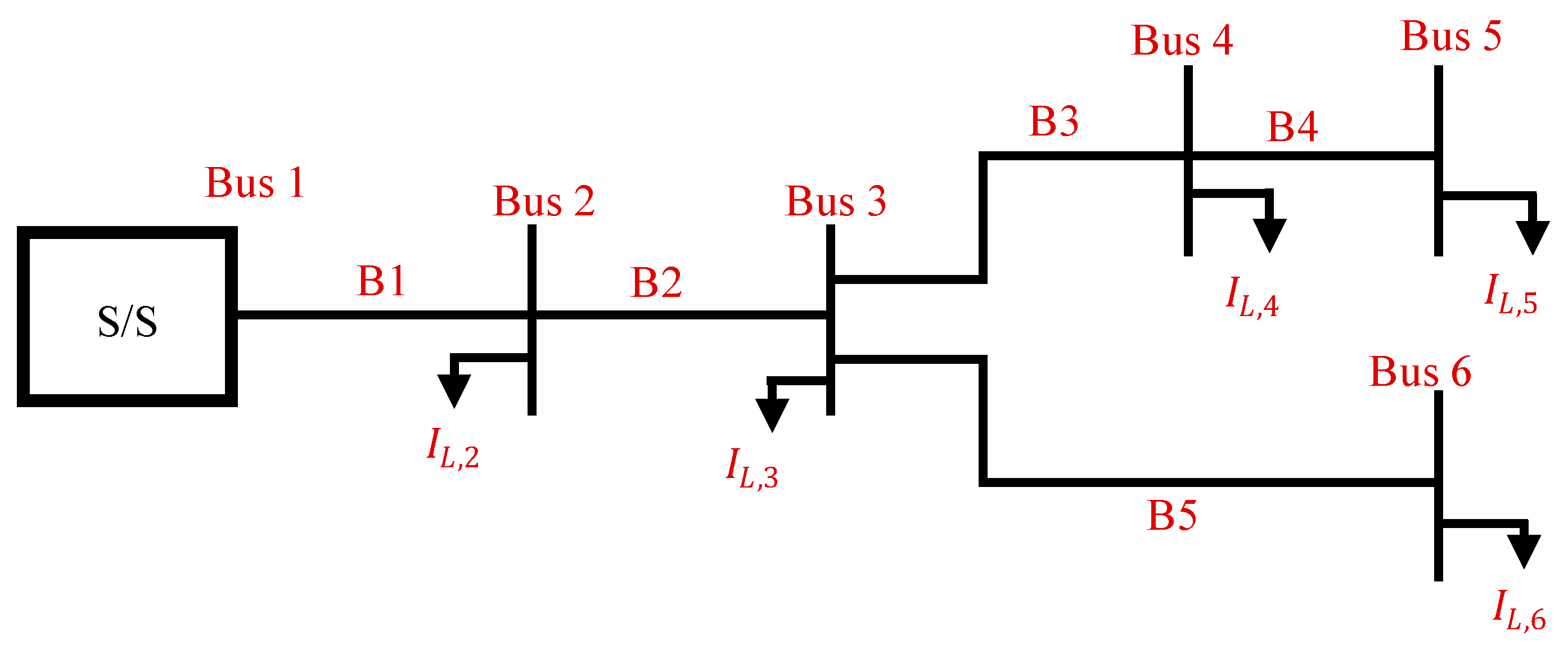
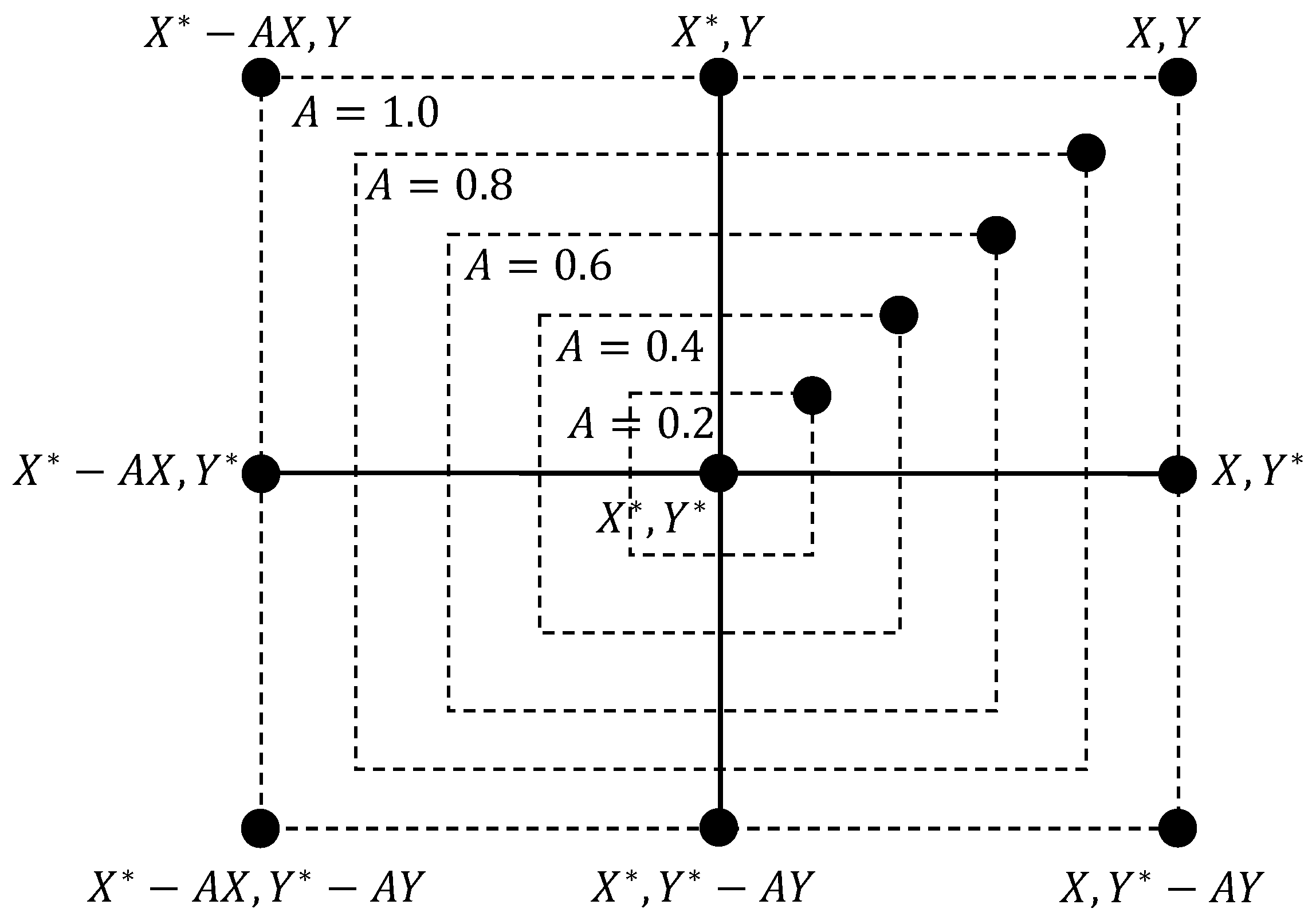



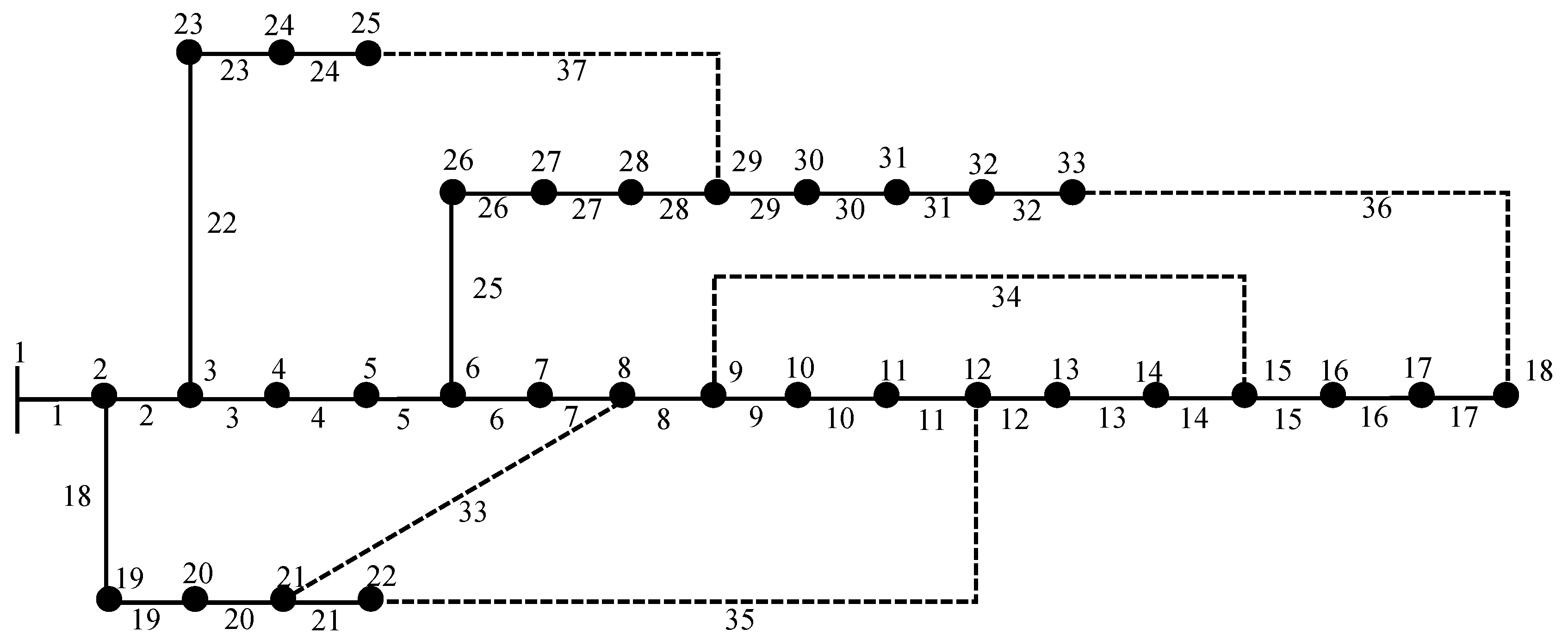
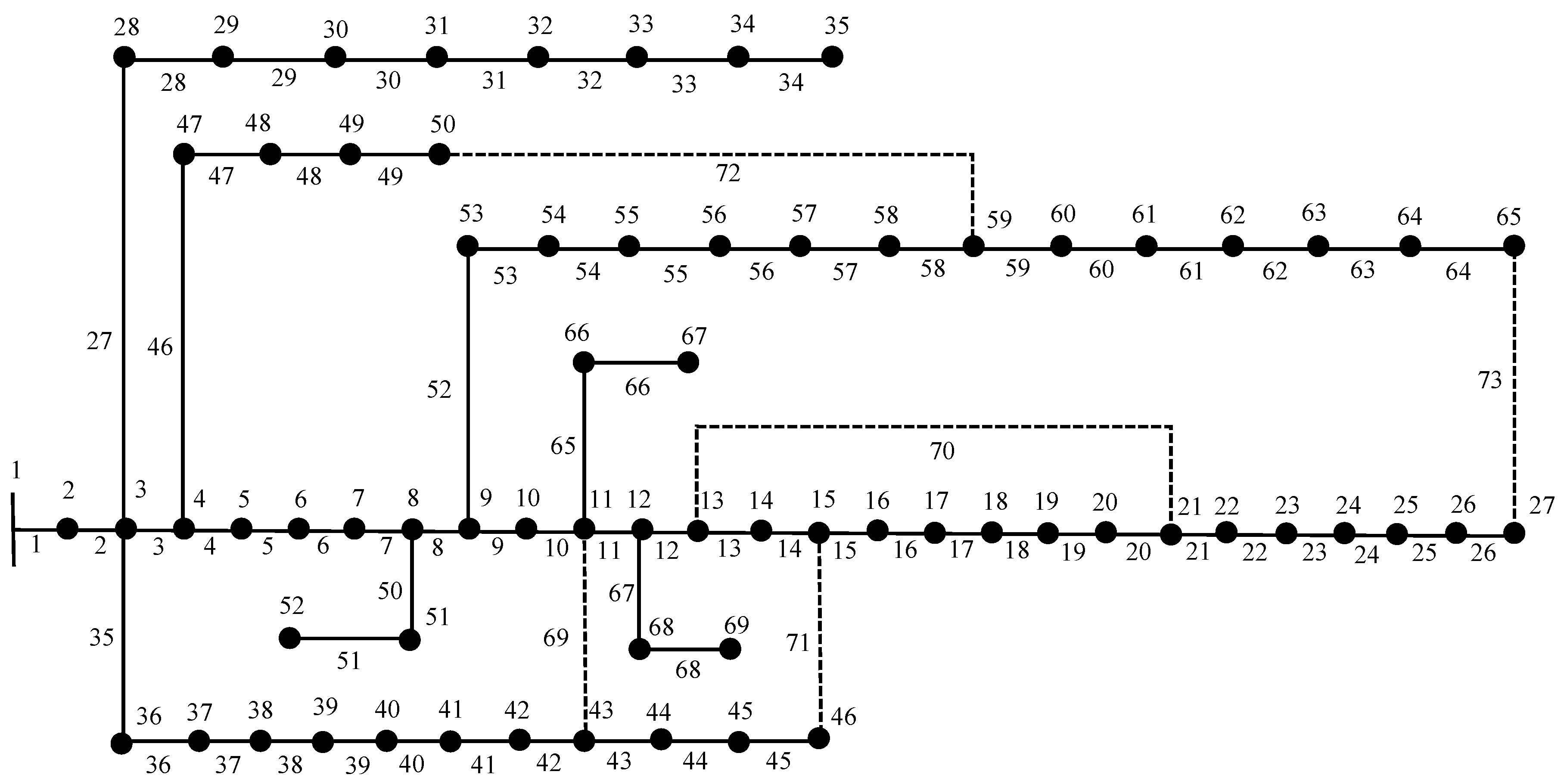
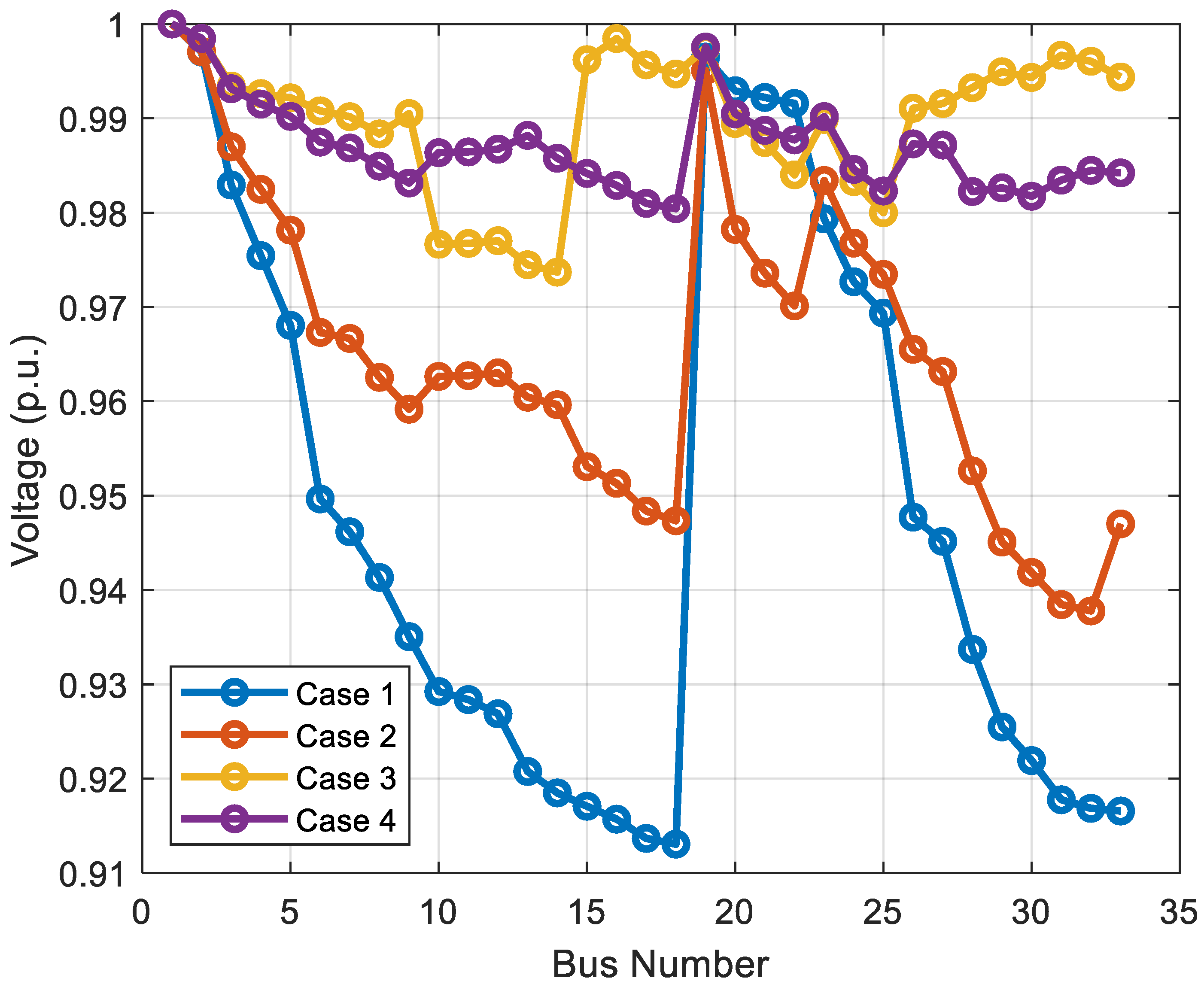
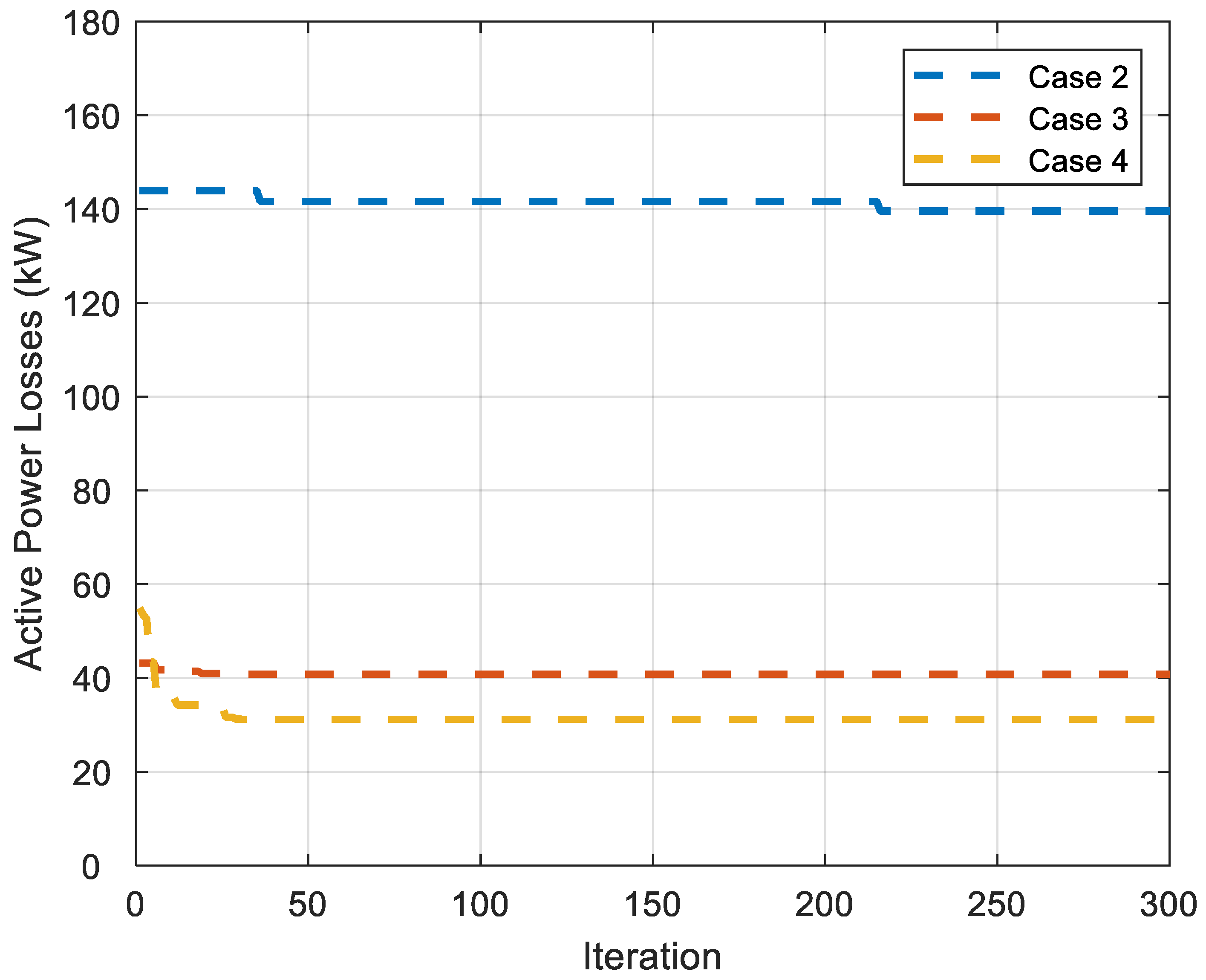


| FL | Switches | Length of the FL |
|---|---|---|
| 1 | 2, 3, 4, 5, 6, 7, 18, 19, 20, 33 | 10 |
| 2 | 9, 10, 11, 12, 13, 14, 34 | 7 |
| 3 | 8, 9, 10, 11, 21, 33, 35 | 7 |
| 4 | 6, 7, 8, 9, 10, 11, 12, 13, 14, 15, 16, 17, 25, 26, 27, 28, 29, 30, 31, 32, 36 | 21 |
| 5 | 3, 4, 5, 22, 23, 24, 25, 26, 27, 28, 37 | 11 |
| FL | Switches | Length of the FL |
|---|---|---|
| 1 | 3, 4, 5, 6, 7, 8, 9, 10, 35, 36, 37, 38, 39, 40, 41, 42, 69 | 17 |
| 2 | 13, 14, 15, 16, 17, 18, 19, 20, 70 | 9 |
| 3 | 11, 12, 13, 14, 43, 44, 45, 69, 71 | 9 |
| 4 | 4, 5, 6, 7, 8, 46, 47, 48, 49, 52, 53, 54, 55, 56, 57, 58, 72 | 17 |
| 5 | 9, 10, 11, 12, 13, 14, 15, 16, 17, 18, 19, 20, 21, 22, 23, 24, 25, 26, 52, 53, 54, 55, 56, 57, 58, 59, 60, 61, 62, 63, 64, 73 | 32 |
| Case | Item | ACSA [1] | UVDA [2] | MPGSA [3] | SFS [4] | WOA |
|---|---|---|---|---|---|---|
| 1 | Opened switches | – | – | – | – | 33-34-35-36-37 |
| (kW) | – | – | – | – | 202.68 | |
| (p.u.) | – | – | – | – | 0.9131 | |
| Time (s) | – | – | – | – | 0.2 | |
| 2 | Opened switches | 7-9-14-28-32 | 7-9-14-32-37 | 7-9-14-32-37 | 7-9-14-32-37 | 7-9-14-32-37 |
| (kW) | 139.98 | 139.55 | 139.55 | 139.55 | 139.55 | |
| Losses reduction (%) | 30.93 | 31.15 | 31.15 | 31.15 | 31.15 | |
| (p.u.) | 0.9413 | 0.9378 | 0.9378 | 0.9378 | 0.9378 | |
| Time (s) | – | – | – | – | 4265.4 | |
| 3 | Opened switches | 7-9-14-28-32 | 7-9-14-32-37 | 7-9-14-32-37 | 7-9-14-32-37 | 7-9-14-32-37 |
| (kW)/(Bus) | 539.7/(12) | 526.0/(12) | 246.9/(31) | 931.7/(8) | 619.2/(16) | |
| 504.5/(16) | 592.0/(15) | 179.5/(32) | 1068.2/(24) | 619.2/(29) | ||
| 1753.6/(29) | 1125.0/(30) | 664.5/(33) | 950.3/(30) | 619.2/(31) | ||
| (kW) | 58.79 | 66.60 | 92.87 | 58.88 | 40.80 | |
| Losses reduction (%) | 71.00 | 67.14 | 54.17 | 70.95 | 79.87 | |
| (p.u.) | 0.9802 | 0.9758 | 0.9482 | 0.9741 | 0.9737 | |
| Time (s) | – | – | – | – | 3926.5 | |
| 4 | Opened switches | 11-28-31-33-34 | – | – | 7-9-14-27-30 | 7-8-9-27-36 |
| (kW)/(Bus) | 964.6/(7) | – | – | 775.3/(22) | 614.0/(13) | |
| 896.8/(18) | – | – | 1285.8/(25) | 610.0/(29) | ||
| 1438.1/(25) | – | – | 735.6/(33) | 613.0/(32) | ||
| (kW) | 53.21 | – | – | 53.01 | 31.17 | |
| Losses reduction (%) | 73.75 | – | – | 73.85 | 84.62 | |
| (p.u.) | 0.9806 | – | – | 0.9720 | 0.9804 | |
| Time (s) | – | – | – | – | 4764.6 |
| Case | Item | ACSA [1] | UVDA [2] | SFS [4] | WOA |
|---|---|---|---|---|---|
| 1 | Opened switches | – | – | – | 69-70-71-72-73 |
| (kW) | – | – | – | 224.96 | |
| Vmin (p.u.) | – | – | – | 0.9090 | |
| Time (s) | – | – | – | 0.3 | |
| 2 | Opened switches | 14-57-61-69-70 | 14-58-61-69-70 | 14-55-61-69-70 | 12-57-61-69-70 |
| (kW) | 98.59 | 98.58 | 98.62 | 99.80 | |
| Losses reduction (%) | 56.16 | 56.19 | 56.17 | 55.64 | |
| (p.u.) | 0.9495 | 0.9495 | 0.9495 | 0.9427 | |
| Time (s) | – | – | – | 27,553.3 | |
| 3 | Opened switches | 14-57-61-69-70 | 14-58-61-69-70 | 14-55-61-69-70 | 12-57-61-69-70 |
| (kW)/(Bus) | 368.6/(12) | 620.0/(11) | 537.6/(11) | 572.0/(27) | |
| 1725.4/(61) | 1378.0/(61) | 1434.0/(61) | 205.0/(60) | ||
| 466.6/(64) | 722.0/(64) | 490.3/(64) | 633.7/(61) | ||
| (kW) | 37.23 | 37.84 | 35.17 | 28.05 | |
| Losses reduction (%) | 83.45 | 83.18 | 84.37 | 87.53 | |
| (p.u.) | 0.9870 | 0.9801 | 0.9813 | 0.9707 | |
| Time (s) | – | – | – | 14,310.7 | |
| 4 | Opened switches | 14-58-61-69-70 | – | 14-56-61-69-70 | 10-12-20-21-58 |
| (kW)/(Bus) | 541.3/(11) | – | 537.6/(11) | 633.7/(62) | |
| 1724.0/(61) | – | 1434.0/(61) | 496.0/(63) | ||
| 553.6/(65) | – | 490.3/(64) | 607.0/(64) | ||
| (kW) | 37.02 | – | 35.16 | 19.49 | |
| Losses reduction (%) | 83.54 | – | 84.37 | 91.34 | |
| (p.u.) | 0.9869 | – | 0.9810 | 0.9820 | |
| Time (s) | – | – | – | 27,902.1 |
Disclaimer/Publisher’s Note: The statements, opinions and data contained in all publications are solely those of the individual author(s) and contributor(s) and not of MDPI and/or the editor(s). MDPI and/or the editor(s) disclaim responsibility for any injury to people or property resulting from any ideas, methods, instructions or products referred to in the content. |
© 2023 by the authors. Licensee MDPI, Basel, Switzerland. This article is an open access article distributed under the terms and conditions of the Creative Commons Attribution (CC BY) license (https://creativecommons.org/licenses/by/4.0/).
Share and Cite
Mahdavi, E.; Asadpour, S.; Macedo, L.H.; Romero, R. Reconfiguration of Distribution Networks with Simultaneous Allocation of Distributed Generation Using the Whale Optimization Algorithm. Energies 2023, 16, 4560. https://doi.org/10.3390/en16124560
Mahdavi E, Asadpour S, Macedo LH, Romero R. Reconfiguration of Distribution Networks with Simultaneous Allocation of Distributed Generation Using the Whale Optimization Algorithm. Energies. 2023; 16(12):4560. https://doi.org/10.3390/en16124560
Chicago/Turabian StyleMahdavi, Elham, Seifollah Asadpour, Leonardo H. Macedo, and Rubén Romero. 2023. "Reconfiguration of Distribution Networks with Simultaneous Allocation of Distributed Generation Using the Whale Optimization Algorithm" Energies 16, no. 12: 4560. https://doi.org/10.3390/en16124560






